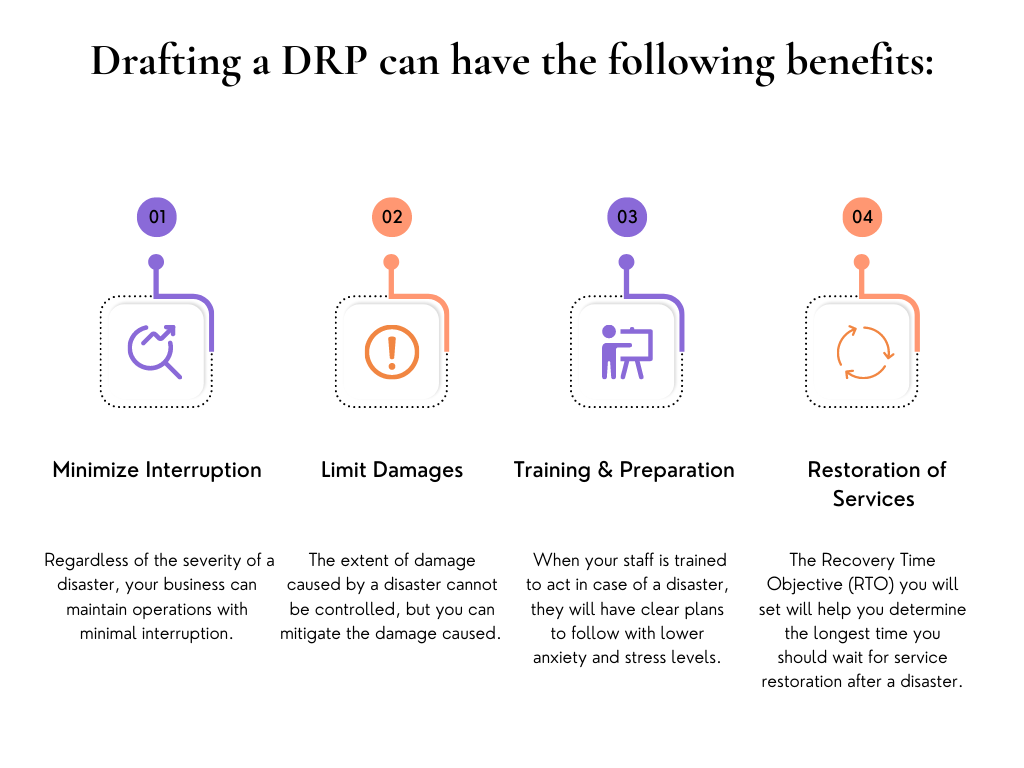
Pre-Requisites for Creating Your 2023 Disaster Recovery Plan(DRP)
Businesses are at risk daily by events beyond their control, such as power outages and natural disasters. But are these the only disasters you need to be mindful of? A study shows that businesses encounter man-made disasters more often than natural ones. And well-planned cyberattacks are among those ways to destroy someone’s business. The number of cybersecurity attacks on businesses worldwide in 2021 was over 600 million, costing businesses millions of dollars, hours, and millions of pieces of data. Every disaster, from the natural to the cyber, can cripple your business. But how can you prepare for such devastating and unfortunate occurrences? The best way to protect your systems is by thinking ahead with Disaster Recovery Planning (DRP).
In this article, you’ll learn
- What Is a Disaster Recovery Plan?
- Why is Disaster Recovery Important?
- Elements to consider before creating your effective DRP.
What Is a Disaster Recovery Plan?
An organization’s Disaster Recovery Plan contains a set of actions that help it restore its technology and operations in the event of a disaster. It is part of security planning and a subset of business continuity planning.
A DRP typically includes the following:
- Disaster Response Procedures Staff can follow
- Outage times for critical IT assets
- Recovery Tools and Technologies
- A Disaster Recovery Team
Why is Disaster Recovery Important?
Without a Disaster Recovery Plan, businesses lose time, effort, revenue, and hundreds or even thousands of dissatisfied customers whose orders have been delayed, whose accounts have been lost, or whose financial information has been stolen. Rather than spending your time trying to resolve an issue without a disaster recovery plan, you will be forced to waste that time correcting the problem and regaining customer trust. And it is for these reasons that having a DRP becomes so important.
Elements for Constructing an Effective DRP
Here are five key points that you should keep in mind before Constructing a Disaster Recovery Plan
1. Know Your Threats
Make sure you understand the history of your business, industry, and region, and map out your most likely threats. Natural disasters, geopolitical events such as wars or civil unrest, failure of critical equipment like servers, Internet connections, or software, and cyber attacks are among the most common risks that may affect your business. So, make sure your Disaster Recovery Plan protects you against all or at least the most likely threats.
2. Evaluate and Prioritize Your Assets
The key is to be comprehensive. Organize your team and make an exhaustive list of all your business’s assets (like network equipment, servers, workstations, software, cloud services, mobile devices, and more) essential for its day-to-day operations. You can then organize your list into Critical assets (without which you cannot operate), Important assets (which can seriously impede some activities), and Other assets (which will not have a major impact on the business).
3. Identify the Metrics- RPOs, and RTOs
As part of a Disaster Recovery Plan, Recovery Point Objectives (RPOs) and Recovery Time Objectives (RTOs) need to be defined to ensure the security of your critical assets. In disaster recovery, RPO indicates how much data is lost and how frequently your company needs to back up data after the loss occurs. And RTO is the time it will take for your system to restore function following an outage.
4. Set Up Disaster Recovery Sites
A secondary offsite backup of your company’s most important data is important as part of any Disaster Recovery Plan. You could lose employees’ information, customer information, and other important data points without a backup.
You can even consider local storage, which provides you with a shorter RTO, meaning you can restore your data almost anytime.
5. Create an Accountability Chart
To ensure everything runs smoothly in the aftermath of a disaster, create a chart stating who is responsible for what. For example, Which contact will be the primary point of contact if your systems crash? Who will contact customers and employees? Who will manage the public response? This chart will make action plans easier to follow and even avoid confusion, allowing your company to resume operations immediately after the disaster.
Conclusion
A DRP protects everything your business has originally designed and developed. So make sure to formulate an effective Disaster Recovery Plan, allocate an emergency response team of experts who understand how to initiate recovery when a disaster occurs, and develop ways to keep your business afloat.
We, CRM Masters, are Digital Transformation Guru. CRM Solutions demonstrated and tailored by our experts for your business will indeed leverage Zoho’s power for you.







